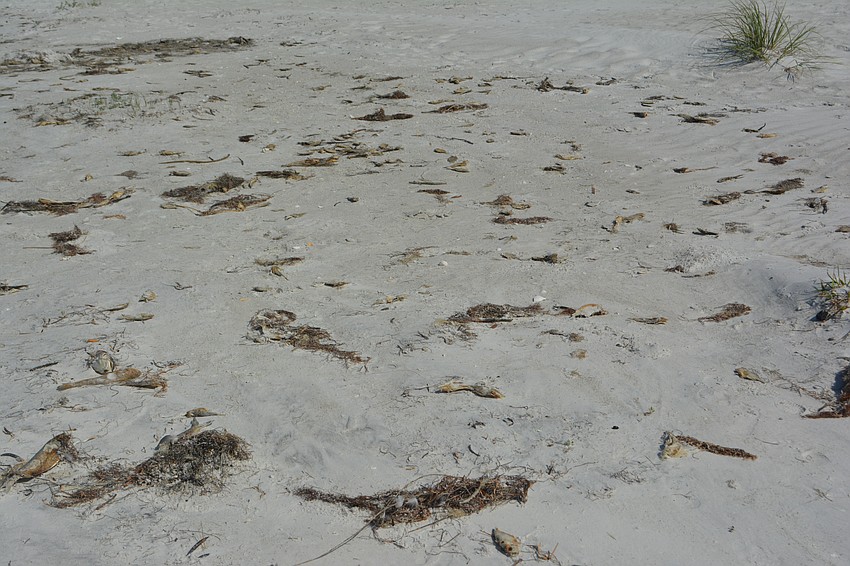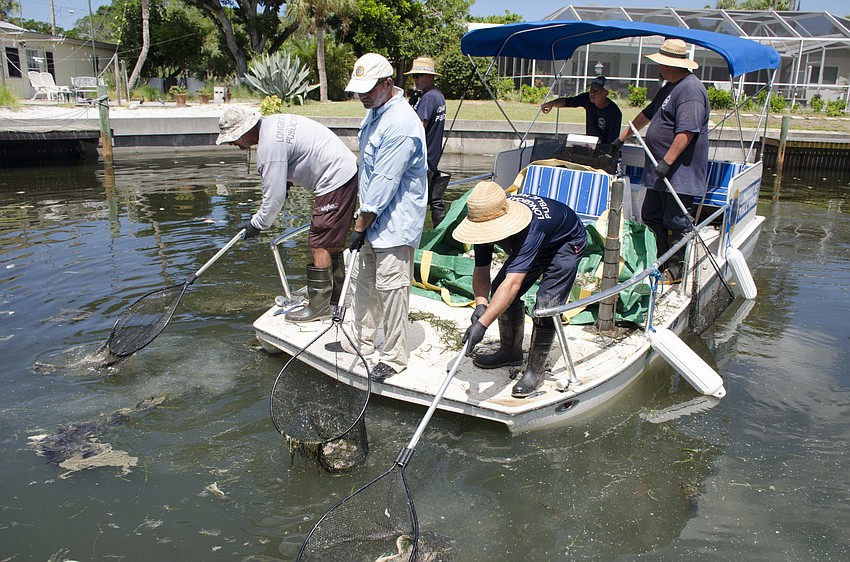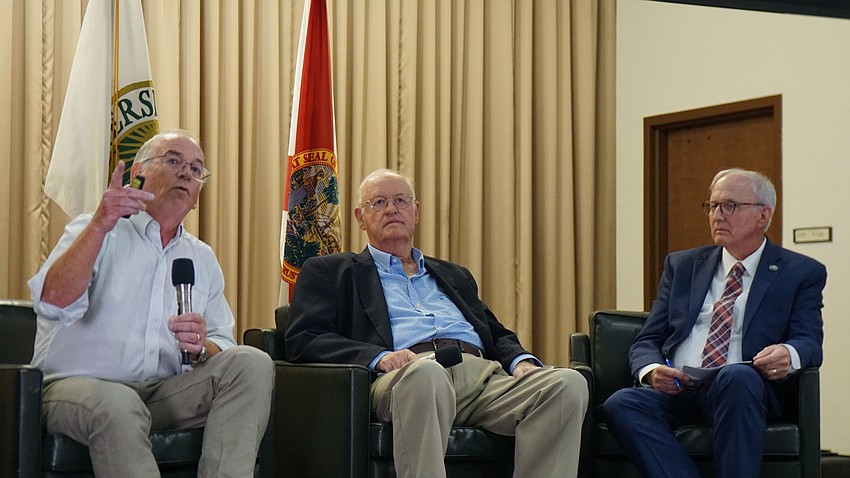- October 23, 2024
-
-
Loading

Loading

Red tide.
It’s a naturally occurring phenomenon, but there are ways to mitigate the impacts.
The "Red Tide in the Gulf Coast" panel discussion on Nov. 13 allowed local officials to share experiences through multiple sectors relating to red tide. The panel was hosted by the Science and Technology Society, along with University of South Florida Sarasota-Manatee.
A show of hands around the USF Sarasota-Manatee auditorium proved everyone in attendance had lived through at least one red tide bloom.
“We still need answers, we still need solutions, we still need people who care and we still need much more information,” USF Sarasota-Manatee Chancellor Karen Holbrook said. “So I think today’s meeting is extremely important.”
The panel was moderated by Barbara Kirkpatrick, senior advisor with the Gulf of Mexico Coastal Ocean Observation System.
She began with a brief introduction to red tide, which is an algal bloom event caused by the microscopic algae Karenia brevis, or K. brevis.
The algae produces toxins that can kill fish, birds and marine mammals. Inhaled toxins by humans or pets can lead to respiratory system issues.

Red tide events have significant impacts on local health, tourism and fisheries, she said.
The mitigation for events can be costly as well, such as cleaning up dead fish from beaches and waterways.
A “perfect storm” is needed to produce bad blooms, like the one in 2017-2018, according to Kirkpatrick. Biology, chemistry and physics all come together to produce, exacerbate and move the bloom onshore.
“That’s really where it wreaks havoc in our community and our lives,” Kirkpatrick said.
She compared red tide blooms to chili. It’s a dish that everyone makes, but everyone’s recipe is different.
“It’s not the same recipe every time,” Kirkpatrick said.
Executive Director of the Sarasota Bay Estuary Program Dave Tomasko followed Kirkpatrick, emphasizing that red tide is naturally occurring, but humans can worsen it.
Nutrient runoff, mainly nitrogen, feeds the K. brevis organism, allowing it to grow. Once the bloom begins, the process of fish kill can also release nitrogen as a byproduct. That starts a cycle that allows K. brevis to be self-sustaining.
Tomasko said the threshold to consider a bloom severe, or in “high abundance,” is 100,000 cells per liter.
In the 2017-2018 bloom event, he said some readings were as high as 14 million cells per liter in Sarasota Bay — 140 times the threshold.

“That was a wicked strong red tide that set us back,” Tomasko said.
Tomasko also shared findings of one of his latest research papers which is currently in review. Results should be viewed as tentative until the paper is accepted, he said
But the preliminary findings proved that the amount of nutrients running into critical waterways that feed Sarasota Bay does have an impact on the duration of red tide events.
“We’ve never not had red tide, but we seem to be making red tide last longer,” Tomasko said.
Sandy Gilbert talked about his organization called Solutions to Avoid Red Tide. Gilbert is the chairman and CEO of the organization.
Gilbert said START focuses on public education, water quality outreach and nutrient control programs.

To inform the public, START has created multiple informative presentations for local groups and homeowners associations about what red tide is and what communities can do to help.
Water quality outreach for START means contacting federal and state legislators, and staying up-to-date with local ordinances. Right now, Gilbert said his organization is working with Sarasota County on an ordinance for “no-mow zones,” where mowing would be prohibited within a certain amount of feet from a pond’s edge.
START also has a focus on stormwater and stormwater pond enhancements, which are a significant source of nutrient runoff.
“About two-thirds of all these ponds flow downstream, … so we’re looking to clean these ponds up so the water in the bay has less nitrogen and doesn’t encourage as much red tide growth,” Gilbert said.
Manatee County Director of the Natural Resources Department Charlie Hunsicker discussed how multiple sectors must work adjacently, and often together, to mitigate the impacts of red tide.
“It takes a village,” he said.
First is governance and policy, which entails working on federal, state and local regulations.
One example is Manatee County’s fertilizer ordinance which went into effect in 2011, said Hunsicker. The goal of the ordinance was to mitigate how much nutrient runoff was occurring from fertilizer during warmer months when red tide blooms are often more frequent.
Since 2010, Hunsicker said the county has seen decreasing nitrogen levels in Nonsense Creek, Gates Creek, Rattlesnake Slough and Cooper Creek.
“Probably about 80% of that reason is the fertilizer ordinance,” Hunsicker said.
Bio-recovery is another sector that is important in mitigating future red tide events. Hunsicker said the county is going to be investing $4 million of grant money into oyster restoration at target sites mainly along the Manatee River.
The oysters help filter the water from nutrients, such as nitrogen.
“It’s using nature to help solve a continuous loading problem of nitrogen,” Hunsicker said.
Treatment measures go hand-in-hand. Effectively reusing treated wastewater and improving nitrogen removal in wastewater are other important factors.
Street sweeping is an area in which Manatee County only invests $400,000 a year, but Hunsicker estimates that act removes about 278 pounds of nitrogen and prevents about 42 tons of algae each year.
It could have a greater impact with more funding and emphasis, he said.
Pre-emption and conservation is also key, Hunsicker said, mainly with public land acquisition. This prevents development and future runoff sources.
One project in the works is the Emerson Point Preserve expansion.
Hunsicker said there’s a space of over 90 acres next to the preserve that is open land, and the county is going after it to expand the preserve.
“It’s lasting, it’s rewarding, it’s beneficial,” Hunsicker said. “It takes public support to task ourselves to set aside that money.”
A Q&A followed Hunsicker’s presentation. When asked what people could expect with red tide in 2024, Tomasko was cautious.
“If we have an El Nino that rains a lot, and we have a hurricane where the water gets warmer, it could be a really bad year,” Tomasko said.
But with all the efforts going on in Sarasota Bay, the three continued to stress the importance of community involvement and support.
“A clean environment is a healthy economy in Florida,” Tomasko said.